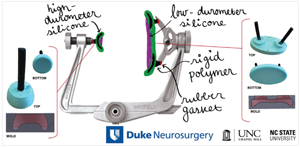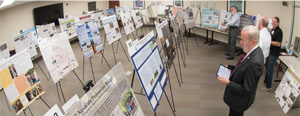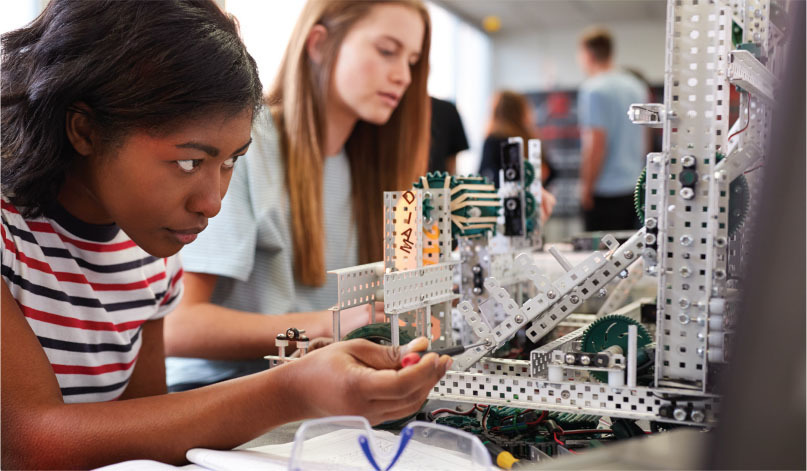September/October 2018
Communities: Education
Pediatric Neurosurgery Project Garners NCEES Grand Prize
A device designed to reduce complications for young children undergoing brain surgery has earned a top award from the National Council of Examiners for Engineering and Surveying for fostering collaboration between students and professional engineers.
North Carolina State University’s joint department of biomedical engineering (with the University of North Carolina at Chapel Hill) took home the NCEES Engineering Education Award and a $25,000 cash prize. NSPE Executive Director Mark Golden served on the judging panel.
The winning project, Enabling Pediatric Brain Surgery Through Head Stabilization, brought together biomedical engineering students with clinicians and engineering professionals to develop a device to completely immobilize pediatric patients during neurosurgery. The same methods used for adults cannot be used on young children, especially those under three years old, because of their fragile skulls. According to the project brief, the inability to safely immobilize pediatric patients’ skulls is a major cause of postoperative complications.
The immobilization of adult patients using a three-pin skull clamp allows the use of neuronavigation, an advanced technology that works with preoperative computed tomography or magnetic resonance images to allow neurosurgeons to know their exact position in the brain.
The process improves surgeon confidence and results in better outcomes, the project description notes. But it’s not usable on young children who cannot be pinned with the traditional methods.
The team aimed to address that challenge. Their design criteria included stability, access to the surgical field, cost, setup time, and pressure distribution. The solution, “the Cradle,” adapts to the currently used device. The disposable polymer pieces increase the surface area contact with the head and decrease localized pressure.
In developing the device, the project team received assistance from various professionals, including a PE mentor who assisted with the design concept, selection of appropriate materials, and molding processes.
The ability to treat ailments that might otherwise go untreated can lead to better quality of life for children and increase independence, the project materials note. “By opening a new frontier of possibilities for treatment of pediatric neurological disorders, including epilepsy, brain tumors, and hydrocephalus, our group is hoping to mend the minds of tomorrow.”
NCEES started the award “to promote understanding of the value of licensure and to encourage partnerships between the engineering profession and education.”
Learn more about the project and the NCEES award.
Additional Awards
Seven other winners received awards of $10,000 each:
-
Miami University (Ohio) Department of Chemical, Paper, and Biomedical Engineering
Design and Implementation of a Community-Driven Water System in a Rural African Village -
Seattle University Department of Civil and Environmental Engineering
Load Rating and Repair Options for Bridge Connecting Dam and Intake Structure -
Seattle University Department of Civil and Environmental Engineering
Replacement Design of a Culvert to Allow for Fish Passage -
University of Minnesota Twin Cities Department of Civil, Environmental, and Geo-Engineering
Multistage Drip Irrigation System in Ethiopia -
University of Nebraska-Lincoln Charles W. Durham School of Architectural Engineering and Construction
Children’s Hospital and Medical Center Expansion -
University of Wisconsin-Madison Department of Civil and Environmental Engineering
Interlake Lock and Boat Transfer -
University of Wisconsin-Madison Department of Civil and Environmental Engineering
Law Park Revitalization


 Volunteering at NSPE is a great opportunity to grow your professional network and connect with other leaders in the field.
Volunteering at NSPE is a great opportunity to grow your professional network and connect with other leaders in the field. The National Society of Professional Engineers (NSPE) encourages you to explore the resources to cast your vote on election day:
The National Society of Professional Engineers (NSPE) encourages you to explore the resources to cast your vote on election day: “THE CRADLE” ATTACHES TO THE STANDARD MAYFIELD DEVICE TO IMMOBILIZE YOUNG BRAIN SURGERY PATIENTS. IT COMBINES RIGID SILICONE TO WITHSTAND AND DISTRIBUTE FORCE WITH SOFTER SILICONE FOR CONTACT WITH THE PATIENT’S HEAD.
“THE CRADLE” ATTACHES TO THE STANDARD MAYFIELD DEVICE TO IMMOBILIZE YOUNG BRAIN SURGERY PATIENTS. IT COMBINES RIGID SILICONE TO WITHSTAND AND DISTRIBUTE FORCE WITH SOFTER SILICONE FOR CONTACT WITH THE PATIENT’S HEAD. NSPE EXECUTIVE DIRECTOR MARK GOLDEN REVIEWS THE ENTRIES FOR THE NCEES ENGINEERING EDUCATION AWARD.
NSPE EXECUTIVE DIRECTOR MARK GOLDEN REVIEWS THE ENTRIES FOR THE NCEES ENGINEERING EDUCATION AWARD.



